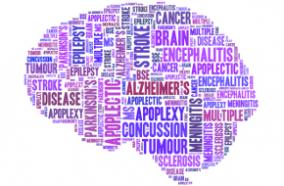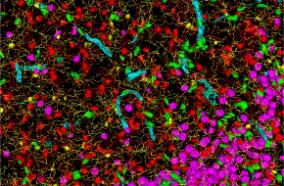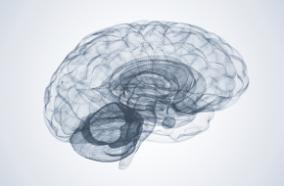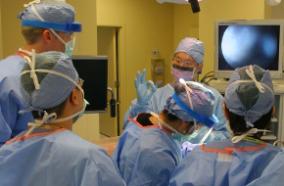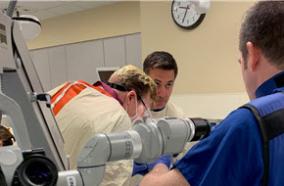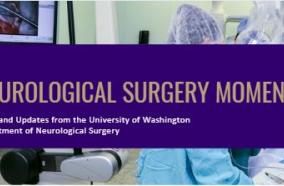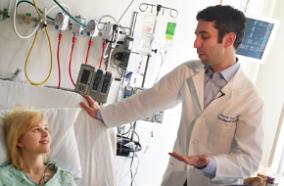5 years 4 months ago
Related Articles
Risk Factors for Suicidal Ideation Following Mild Traumatic Brain Injury: A TRACK-TBI Study.
J Head Trauma Rehabil. 2020 Jul 22;:
Authors: Campbell-Sills L, Jain S, Sun X, Fisher LB, Agtarap SD, Dikmen S, Nelson LD, Temkin N, McCrea M, Yuh E, Giacino JT, Manley GT, Stein MB, TRACK-TBI Investigators
Abstract
OBJECTIVE: To identify risk factors for suicidal ideation (SI) following mild traumatic brain injury (mTBI).
SETTING: Eleven US level 1 trauma centers.
PARTICIPANTS: A total of 1158 emergency department patients with mTBI (Glasgow Coma Scale score = 13-15) enrolled in the Transforming Research and Clinical Knowledge in Traumatic Brain Injury (TRACK-TBI) study.
DESIGN: Prospective observational study; weights-adjusted multivariable logistic regression models (n's = 727-883) estimated associations of baseline factors and post-TBI symptoms with SI at 2 weeks and 3, 6, and 12 months postinjury.
MAIN MEASURES: Patient Health Questionnaire, Rivermead Post-Concussion Symptoms Questionnaire.
RESULTS: Preinjury psychiatric history predicted SI at all follow-ups (adjusted odds ratios [AORs] = 2.26-6.33, P values <.05) and history of prior TBI predicted SI at 2 weeks (AOR = 2.36, 95% confidence interval [CI] = 1.16-4.81, P = .018), 3 months (AOR = 2.62, 95% CI = 1.33-5.16, P = .005), and 6 months postinjury (AOR = 2.54, 95% CI = 1.19-5.42, P = .016). Adjusting for these baseline factors, post-TBI symptoms were strongly associated with SI at concurrent (AORs = 1.91-2.88 per standard deviation unit increase in Rivermead Post-Concussion Symptoms Questionnaire score; P values <.0005) and subsequent follow-up visits (AORs = 1.68-2.53; P values <.005). Most of the associations between post-TBI symptoms and SI were statistically explained by co-occurring depression.
CONCLUSION: Screening for psychiatric and prior TBI history may help identify patients at risk for SI following mTBI. Awareness of the strong associations of post-TBI symptoms with SI may facilitate interventions to prevent suicide-related outcomes in patients with mTBI.
PMID: 32769835 [PubMed - as supplied by publisher]
5 years 4 months ago
Related Articles
The Stigma of Sexually Transmitted Infections.
Nurs Clin North Am. 2020 09;55(3):295-305
Authors: Lee ASD, Cody SL
Abstract
Evidence-based guidelines have improved diagnosis and treatment of sexually transmitted infections (STI). Social stigma remains a barrier to STI testing and is associated with underutilization of prevention services. Alternatives for STI testing (eg, in-home testing) are convenient. However, some individuals decline follow-up treatment in fear of unintentional disclosure of their diagnosis. This article reviews STI treatment guidelines and examines the impact of stigma and ethical issues on testing, adherence, partner notification, and transmission rates. An understanding of STI-associated ethical issues and controversies is an important step toward eliminating stigma and reducing STI prevalence and morbidity.
PMID: 32762851 [PubMed - indexed for MEDLINE]
5 years 4 months ago
Related Articles
Rhinovirus Infection Drives Complex Host Airway Molecular Responses in Children With Cystic Fibrosis.
Front Immunol. 2020;11:1327
Authors: Ling KM, Garratt LW, Gill EE, Lee AHY, Agudelo-Romero P, Sutanto EN, Iosifidis T, Rosenow T, Turvey SE, Lassmann T, Hancock REW, Kicic A, Stick SM
Abstract
Early-life viral infections are responsible for pulmonary exacerbations that can contribute to disease progression in young children with cystic fibrosis (CF). The most common respiratory viruses detected in the CF airway are human rhinoviruses (RV), and augmented airway inflammation in CF has been attributed to dysregulated airway epithelial responses although evidence has been conflicting. Here, we exposed airway epithelial cells from children with and without CF to RV in vitro. Using RNA-Seq, we profiled the transcriptomic differences of CF and non-CF airway epithelial cells at baseline and in response to RV. There were only modest differences between CF and non-CF cells at baseline. In response to RV, there were 1,442 and 896 differentially expressed genes in CF and non-CF airway epithelial cells, respectively. The core antiviral responses in CF and non-CF airway epithelial cells were mediated through interferon signaling although type 1 and 3 interferon signaling, when measured, were reduced in CF airway epithelial cells following viral challenge consistent with previous reports. The transcriptional responses in CF airway epithelial cells were more complex than in non-CF airway epithelial cells with diverse over-represented biological pathways, such as cytokine signaling and metabolic and biosynthetic pathways. Network analysis highlighted that the differentially expressed genes of CF airway epithelial cells' transcriptional responses were highly interconnected and formed a more complex network than observed in non-CF airway epithelial cells. We corroborate observations in fully differentiated air-liquid interface (ALI) cultures, identifying genes involved in IL-1 signaling and mucin glycosylation that are only dysregulated in the CF airway epithelial response to RV infection. These data provide novel insights into the CF airway epithelial cells' responses to RV infection and highlight potential pathways that could be targeted to improve antiviral and anti-inflammatory responses in CF.
PMID: 32765492 [PubMed - as supplied by publisher]
5 years 4 months ago
Related Articles
Bayesian priors in estimates of object location in virtual reality.
Psychon Bull Rev. 2020 Aug 06;:
Authors: Sampaio C, Jones M, Engelbertson A, Williams M
Abstract
We investigated the category bias in spatial memory, which reveals the influence of a region (i.e., a spatial category) on memory for specific locations within the region's bounds. The standard approach to investigating the category bias employs a static dot-in-circle task, in which observers indicate the location of a single dot from memory after a brief interval. The agreement in the literature is that these location estimates result from Bayesian principles; however, the priors in the dot-in-circle task are geometric prototypes (the central angular value of each quadrant and two-thirds of the radius from the center of the circle to its circumference). These geometric prototypes are not "true" priors in that they are not pre-existing statistical likelihoods of a target's location before other evidence is considered. In this paper, we tested the category bias with items for which informative priors exist (e.g., a vase, which is expected to be in the center of a table) and found that people favor them over geometric prototypes for estimating angular but not radial target positions. Our work contributes to the literature by showing that localizing common everyday objects in a circular space is not restricted to the use of cues intrinsic to the space. This is important because the majority of the empirical data on the category bias derives from locating targets that have little to no semantic information.
PMID: 32767045 [PubMed - as supplied by publisher]
5 years 4 months ago
Related Articles
Guidelines for the Management of Severe Traumatic Brain Injury: 2020 Update of the Decompressive Craniectomy Recommendations.
Neurosurgery. 2020 09 01;87(3):427-434
Authors: Hawryluk GWJ, Rubiano AM, Totten AM, O'Reilly C, Ullman JS, Bratton SL, Chesnut R, Harris OA, Kissoon N, Shutter L, Tasker RC, Vavilala MS, Wilberger J, Wright DW, Lumba-Brown A, Ghajar J
Abstract
When the fourth edition of the Brain Trauma Foundation's Guidelines for the Management of Severe Traumatic Brain Injury were finalized in late 2016, it was known that the results of the RESCUEicp (Trial of Decompressive Craniectomy for Traumatic Intracranial Hypertension) randomized controlled trial of decompressive craniectomy would be public after the guidelines were released. The guideline authors decided to proceed with publication but to update the decompressive craniectomy recommendations later in the spirit of "living guidelines," whereby topics are updated more frequently, and between new editions, when important new evidence is published. The update to the decompressive craniectomy chapter presented here integrates the findings of the RESCUEicp study as well as the recently published 12-mo outcome data from the DECRA (Decompressive Craniectomy in Patients With Severe Traumatic Brain Injury) trial. Incorporation of these publications into the body of evidence led to the generation of 3 new level-IIA recommendations; a fourth previously presented level-IIA recommendation remains valid and has been restated. To increase the utility of the recommendations, we added a new section entitled Incorporating the Evidence into Practice. This summary of expert opinion provides important context and addresses key issues for practitioners, which are intended to help the clinician utilize the available evidence and these recommendations. The full guideline can be found at: https://braintrauma.org/guidelines/guidelines-for-the-management-of-severe-tbi-4th-ed#/.
PMID: 32761068 [PubMed - indexed for MEDLINE]
5 years 4 months ago
Related Articles
Estimation of Fractional Extracellular Space at CT for Predicting Chemotherapy Response and Survival in Pancreatic Ductal Adenocarcinoma.
AJR Am J Roentgenol. 2020 09;215(3):610-616
Authors: Wang ZJ, Zhang TT, An C, Ko AH, Tempero M, Collisson E, Yeh BM
Abstract
OBJECTIVE. The purpose of this study was to investigate the association between primary pancreatic ductal adenocarcinoma fractional extracellular space (fECS) estimated from pretreatment CT and tumor response to chemotherapy and patient outcome. MATERIALS AND METHODS. A database search identified the records of patients with locally advanced or metastatic pancreatic ductal adenocarcinoma treated with systemic therapies who had undergone pretreatment CT that included both unenhanced and equilibrium phase images. An ROI was placed on the primary tumor and aorta, and the tumor fECS was calculated as follows: (tumor attenuation in the equilibrium phase - tumor attenuation in the unenhanced phase) / (aortic attenuation in the equilibrium phase - aortic attenuation in the unenhanced phase) × (1 - hematocrit). Response to therapy was assessed in subsequent CT examinations according to the Response Evaluation Criteria in Solid Tumors version 1.1. Relevant clinical variables, including carbohydrate antigen 19-9 level, chemotherapy regimen, and survival were recorded. Multivariate analyses were performed to determine the predictors of treatment response and patient survival. RESULTS. The median primary tumor fECS was 0.41 (range, 0.02-0.69). When dichotomized to high (> 0.41) versus low fECS (≤ 0.41) values, a larger proportion of patients with high tumor fECS values achieved disease control after chemotherapy than did those with low tumor fECS values: full cohort, 27 of 30 versus 19 of 30 (p = 0.030); cohort with locally advanced disease, 23 of 24 versus 10 of 15 (p = 0.024). The mean progression-free survival among patients with high primary tumor fECS values was significantly longer than that among those with low fECS values (191 versus 115 days, p = < 0.0001). Primary tumor fECS was an independent predictor of progression-free survival (p = 0.003) in multivariate analysis. CONCLUSION. High primary tumor fECS value estimated from staging CT was associated with chemotherapy response and progression-free survival of patients with advanced pancreatic ductal adenocarcinoma.
PMID: 32755156 [PubMed - indexed for MEDLINE]
5 years 4 months ago
Related Articles
Both Small and Large Infrarenal Aortic Size is Associated with an Increased Prevalence of Ischaemic Heart Disease.
Eur J Vasc Endovasc Surg. 2020 10;60(4):594-601
Authors: Jones GT, Drinkwater B, Blake-Barlow A, Hill GB, Williams MJA, Krysa J, van Rij AM, Coffey S
Abstract
OBJECTIVE: Past studies have suggested a potential "J shaped" relationship between infrarenal aortic diameter and both cardiovascular disease (CVD) prevalence and all cause mortality. However, screening programmes have focused primarily on large (aneurysmal) aortas. In addition, aortic diameter is rarely adjusted for body size, which is particularly important for women. This study aimed to investigate specifically the relationship between body size adjusted infrarenal aortic diameter and baseline prevalence of CVD.
METHODS: A retrospective analysis was performed on a total of 4882 elderly (>50 years) participants (mean age 69.4 ± 8.9 years) for whom duplex ultrasound to assess infrarenal abdominal aortic diameters had been performed. History of CVDs, including ischaemic heart disease (IHD), and associated risk factors were collected at the time of assessment. A derivation cohort of 1668 participants was used to select cut offs at the lower and upper 12.5% tails of the aortic size distributions (aortic size index of <0.84 and >1.2, respectively), which was then tested in a separate cohort.
RESULTS: A significantly elevated prevalence of CVD, and specifically IHD, was observed in participants with both small and large aortas. These associations remained significant following adjustment for age, sex, diabetes, hypertension, dyslipidaemia, obesity (body mass index), and smoking.
CONCLUSION: The largest and smallest infrarenal aortic sizes were both associated with prevalence of IHD. In addition to identifying those with aneurysmal disease, it is hypothesised that screening programmes examining infrarenal aortic size may also have the potential to improve global CVD risk prediction by identifying those with small aortas.
PMID: 32753305 [PubMed - indexed for MEDLINE]
5 years 4 months ago
Related Articles
The Stringent Stress Response Controls Proteases and Global Regulators under Optimal Growth Conditions in Pseudomonas aeruginosa.
mSystems. 2020 Aug 04;5(4):
Authors: Pletzer D, Blimkie TM, Wolfmeier H, Li Y, Baghela A, Lee AHY, Falsafi R, Hancock REW
Abstract
The bacterial stringent stress response, mediated by the signaling molecule guanosine tetraphosphate, ppGpp, has recently gained attention as being important during normal cellular growth and as a potential new therapeutic target, which warrants detailed mechanistic understanding. Here, we used intracellular protein tracking in Pseudomonas aeruginosa PAO1, which indicated that RelA was bound to the ribosome, while SpoT localized at the cell poles. Transcriptome sequencing (RNA-Seq) was used to investigate the transcriptome of a ppGpp-deficient strain under nonstressful, nutrient-rich broth conditions where the mutant grew at the same rate as the parent strain. In the exponential growth phase, the lack of ppGpp led to >1,600 transcriptional changes (fold change cutoff of ±1.5), providing further novel insights into the normal physiological role of ppGpp. The stringent response was linked to gene expression of various proteases and secretion systems, including aprA, PA0277, impA, and clpP2 The previously observed reduction in cytotoxicity toward red blood cells in a stringent response mutant appeared to be due to aprA Investigation of an aprA mutant in a murine skin infection model showed increased survival rates of mice infected with the aprA mutant, consistent with previous observations that stringent response mutants have reduced virulence. In addition, the overexpression of relA, but not induction of ppGpp with serine hydroxamate, dysregulated global transcriptional regulators as well as >30% of the regulatory networks controlled by AlgR, OxyR, LasR, and AmrZ. Together, these data expand our knowledge about ppGpp and its regulatory network and role in environmental adaptation. It also confirms its important role throughout the normal growth cycle of bacteria.IMPORTANCE Microorganisms need to adapt rapidly to survive harsh environmental changes. Here, we showed the broad influence of the highly studied bacterial stringent stress response under nonstressful conditions that indicate its general physiological importance and might reflect the readiness of bacteria to respond to and activate acute stress responses. Using RNA-Seq to investigate the transcriptional network of Pseudomonas aeruginosa cells revealed that >30% of all genes changed expression in a stringent response mutant under optimal growth conditions. This included genes regulated by global transcriptional regulators and novel downstream effectors. Our results help to understand the importance of this stress regulator in bacterial lifestyle under relatively unstressed conditions. As such, it draws attention to the consequences of targeting this ubiquitous bacterial signaling molecule.
PMID: 32753509 [PubMed]
5 years 4 months ago
Related Articles
Heart Failure With Reduced Ejection Fraction: A Review.
JAMA. 2020 Aug 04;324(5):488-504
Authors: Murphy SP, Ibrahim NE, Januzzi JL
Abstract
Importance: Worldwide, the burden of heart failure has increased to an estimated 23 million people, and approximately 50% of cases are HF with reduced ejection fraction (HFrEF).
Observations: Heart failure is a clinical syndrome characterized by dyspnea or exertional limitation due to impairment of ventricular filling or ejection of blood or both. HFrEF occurs when the left ventricular ejection fraction (LVEF) is 40% or less and is accompanied by progressive left ventricular dilatation and adverse cardiac remodeling. Assessment for heart failure begins with obtaining a medical history and physical examination. Also central to diagnosis are elevated natriuretic peptides above age- and context-specific thresholds and identification of left ventricular systolic dysfunction with LVEF of 40% or less as measured by echocardiography. Treatment strategies include the use of diuretics to relieve symptoms and application of an expanding armamentarium of disease-modifying drug and device therapies. Unless there are specific contraindications, patients with HFrEF should be treated with a β-blocker and one of an angiotensin receptor-neprilysin inhibitor, angiotensin-converting enzyme inhibitor, or angiotensin receptor blocker as foundational therapy, with addition of a mineralocorticoid receptor antagonist in patients with persistent symptoms. Ivabradine and hydralazine/isosorbide dinitrate also have a role in the care of certain patients with HFrEF. More recently, sodium-glucose cotransporter 2 (SGLT2) inhibitors have further improved disease outcomes, significantly reducing cardiovascular and all-cause mortality irrespective of diabetes status, and vericiguat, a soluble guanylate cyclase stimulator, reduces heart failure hospitalization in high-risk patients with HFrEF. Device therapies may be beneficial in specific subpopulations, such as cardiac resynchronization therapy in patients with interventricular dyssynchrony, transcatheter mitral valve repair in patients with severe secondary mitral regurgitation, and implantable cardiac defibrillators in patients with more severe left ventricular dysfunction particularly of ischemic etiology.
Conclusions and Relevance: HFrEF is a major public health concern with substantial morbidity and mortality. The management of HFrEF has seen significant scientific breakthrough in recent decades, and the ability to alter the natural history of the disease has never been better. Recent developments include SGLT2 inhibitors, vericiguat, and transcatheter mitral valve repair, all of which incrementally improve prognosis beyond foundational neurohormonal therapies. Disease morbidity and mortality remain high, with a 5-year survival rate of 25% after hospitalization for HFrEF.
PMID: 32749493 [PubMed - indexed for MEDLINE]
5 years 4 months ago
Related Articles
Early-Onset Familial Alzheimer's Disease Variant PSEN2 N141I Heterozygosity is Associated with Altered Microglia Phenotype.
J Alzheimers Dis. 2020 Jul 24;:
Authors: Fung S, Smith CL, Prater KE, Case A, Green K, Osnis L, Winston C, Kinoshita Y, Sopher B, Morrison RS, Garden GA, Jayadev S
Abstract
BACKGROUND: Early-onset familial Alzheimer disease (EOFAD) is caused by heterozygous variants in the presenilin 1 (PSEN1), presenilin 2 (PSEN2), and APP genes. Decades after their discovery, the mechanisms by which these genes cause Alzheimer's disease (AD) or promote AD progression are not fully understood. While it is established that presenilin (PS) enzymatic activity produces amyloid-β (Aβ), PSs also regulate numerous other cellular functions, some of which intersect with known pathogenic drivers of neurodegeneration. Accumulating evidence suggests that microglia, resident innate immune cells in the central nervous system, play a key role in AD neurodegeneration.
OBJECTIVE: Previous work has identified a regulatory role for PS2 in microglia. We hypothesized that PSEN2 variants lead to dysregulated microglia, which could further contribute to disease acceleration. To mimic the genotype of EOFAD patients, we created a transgenic mouse expressing PSEN2 N141I on a mouse background expressing one wildtype PS2 and two PS1 alleles.
RESULTS: Microglial expression of PSEN2 N141I resulted in impaired γ-secretase activity as well as exaggerated inflammatory cytokine release, NFκB activity, and Aβ internalization. In vivo, PS2 N141I mice showed enhanced IL-6 and TREM2 expression in brain as well as reduced branch number and length, an indication of "activated" morphology, in the absence of inflammatory stimuli. LPS intraperitoneal injection resulted in higher inflammatory gene expression in PS2 N141I mice brain relative to controls.
CONCLUSION: Our findings demonstrate that PSEN2 N141I heterozygosity is associated with disrupted innate immune homeostasis, suggesting EOFAD variants may promote disease progression through non-neuronal cells beyond canonical dysregulated Aβ production.
PMID: 32741831 [PubMed - as supplied by publisher]
5 years 4 months ago
Related Articles
Anaplastic Transformation in Myxopapillary Ependymoma: A Report of 2 Cases and Review of the Literature.
J Neuropathol Exp Neurol. 2020 Aug 02;:
Authors: Gitto L, Serinelli S, Galbraith K, Williams M, Mirchia K, Galgano MA, Krishnamurthy S, de la Roza G, Viapiano MS, Walker JM, Jour G, Serrano J, DeLorenzo M, Snuderl M, Richardson TE
Abstract
Myxopapillary ependymoma (MPE) is a relatively common neoplasm arising primarily in the filum terminale/lumbosacral region of the spinal cord. It is designated as a grade I tumor in the most recent WHO Classification of Tumours of the CNS, although aggressive clinical behavior can be observed, especially in cases arising in an extradural location. Anaplastic transformation in MPE is exceedingly rare with <20 examples reported in the English literature, and consensus on diagnostic features and definitive grading remain to be determined. Here, we present 2 cases of recurrent MPE with anaplastic features, both of which had histology consistent with conventional MPE as well as areas with significant atypia, frequent mitotic figures, elevated Ki-67 proliferation indices (>10%-50%), necrosis, and focal vascular proliferation. Targeted next-generation sequencing panels revealed no definitive pathogenic mutations or fusion proteins in either case. Copy number profiling, methylation profiling, and t-Distributed Stochastic Neighbor Embedding were performed to investigate the molecular characteristics of these tumors. To the best of our knowledge, these are the first reported cases of MPE with anaplastic features with methylation profiling data. In addition, we review the literature and discuss common histologic and molecular findings associated with anaplastic features in MPE.
PMID: 32743660 [PubMed - as supplied by publisher]
5 years 4 months ago
A Humanized Mouse Model for Plasmodium vivax to Test Interventions that Block Liver Stage to Blood Stage Transition and Blood Stage Infection.
iScience. 2020 Jul 18;23(8):101381
Authors: Schäfer C, Roobsoong W, Kangwanrangsan N, Bardelli M, Rawlinson TA, Dambrauskas N, Trakhimets O, Parthiban C, Goswami D, Reynolds LM, Kennedy SY, Flannery EL, Murphy SC, Sather DN, Draper SJ, Sattabongkot J, Mikolajczak SA, Kappe SHI
Abstract
The human malaria parasite Plasmodium vivax remains vastly understudied, mainly due to the lack of suitable laboratory models. Here, we report a humanized mouse model to test interventions that block P. vivax parasite transition from liver stage infection to blood stage infection. Human liver-chimeric FRGN huHep mice infected with P. vivax sporozoites were infused with human reticulocytes, allowing transition of exo-erythrocytic merozoites to reticulocyte infection and development into all erythrocytic forms, including gametocytes, in vivo. In order to test the utility of this model for preclinical assessment of interventions, the invasion blocking potential of a monoclonal antibody targeting the essential interaction of the P. vivax Duffy Binding Protein with the Duffy antigen receptor was tested by passive immunization. This antibody inhibited invasion by over 95%, providing unprecedented in vivo evidence that PvDBP constitutes a promising blood stage vaccine candidate and proving our model highly suitable to test blood stage interventions.
PMID: 32739836 [PubMed - as supplied by publisher]
5 years 4 months ago
Related Articles
Transient Administration of Dopaminergic Precursor Causes Inheritable Overfeeding Behavior in Young Drosophila melanogaster Adults.
Brain Sci. 2020 Jul 28;10(8):
Authors: Moulin TC, Ferro F, Berkins S, Hoyer A, Williams MJ, Schiöth HB
Abstract
Imbalances in dopaminergic signaling during development have been indicated as part of the underlying neurobiology of several psychiatric illnesses, including schizophrenia, major depression, bipolar disorder, and food addiction. Yet, how transient manipulation of dopaminergic signaling influences long-lasting behavioral consequences, or if these modifications can induce inheritable traits, it is still not understood. In this study, we used the Drosophila melanogaster model to test if transient pharmacological activation of the dopaminergic system leads to modulations of feeding and locomotion in adult flies. We observed that transient administration of a dopaminergic precursor, levodopa, at 6 h, 3 days or 5 days post-eclosion, induced overfeeding behavior, while we did not find significant effects on locomotion. Moreover, this phenotype was inherited by the offspring of flies treated 6 h or 3 days post-eclosion, but not the offspring of those treated 5 days post-eclosion. These results indicate that transient alterations in dopaminergic signaling can produce behavioral alterations in adults, which can then be carried to descendants. These findings provide novel insights into the conditions in which environmental factors can produce transgenerational eating disorders.
PMID: 32731370 [PubMed]
5 years 4 months ago
Related Articles
Dural venous sinus stenting for treatment of pediatric idiopathic intracranial hypertension.
J Neurointerv Surg. 2020 Jul 30;:
Authors: Lee KE, Zehri A, Soldozy S, Syed H, Catapano JS, Maurer R, Albuquerque FC, Liu KC, Wolfe SQ, Brown S, Levitt MR, Fargen KM
Abstract
BACKGROUND: Dural venous sinus stenting (VSS) is an effective treatment for idiopathic intracranial hypertension (IIH) in adult patients. There are no published series to date evaluating safety and efficacy of VSS in pediatric patients.
OBJECTIVE: To report on procedural device selection and technique as well as safety and efficacy of VSS for pediatric patients with medically refractory IIH due to underlying venous sinus stenosis.
METHODS: A multi-institutional retrospective case series identified patients with medically refractory IIH aged less than 18 years who underwent VSS.
RESULTS: 14 patients were identified at four participating centers. Patient ages ranged from 10 to 17 years, and 10 patients (71.4%) were female. Mean body mass index was 25.7 kg/m2 (range 15.8-34.6 kg/m2). Stenting was performed under general endotracheal anesthesia in all except two patients. The average trans-stenotic gradient during diagnostic venography was 10.6 mm Hg. Patients had stents placed in the superior sagittal sinus, transverse sinus, sigmoid sinus, occipital sinus, and a combination. Average follow-up was 1.7 years after stenting. Six patients out of 10 (60%) had reduced medication dosing, 12 of 14 patients (85.7%) had improvements in headaches, two patients (100%) with pre-stent tinnitus had resolution of symptoms, and four (80%) of five patients with papilledema had improvement on follow-up ophthalmological examinations. Two patients (14.3%) developed postprocedural groin hematomas, one patient (7.1%) developed a groin pseudoaneurysm, and one patient (7.1%) had postprocedural groin bleeding. No other procedural complications occurred. Four patients (28.6%) required further surgical treatment (cerebrospinal shunting and/or stenting) after their first stenting procedure.
CONCLUSIONS: This series suggests that VSS is feasible in a pediatric population with IIH and has a low complication rate and good clinical outcomes.
PMID: 32732257 [PubMed - as supplied by publisher]
5 years 4 months ago
Related Articles
Trends in Australian inguinal hernia repair rates: a 15-year population study.
ANZ J Surg. 2020 Jul 31;:
Authors: Williams ML, Hutchinson AG, Oh DD, Young CJ
Abstract
BACKGROUND: An inguinal hernia is one of the most common surgical pathologies, and therefore the repair of an inguinal hernia is one of the most common general surgical procedures. The aim of this study was to assess the trend in inguinal hernia repair (IHR) rates in Australia between 2000/2001 and 2014/2015 using population data from public and private hospitals.
METHODS: ICD-10 data cubes from the Australian Institute of Health and Welfare were analysed to determine the number of inguinal hernia repairs performed, open or laparoscopically, between 2000/2001 and 2014/2015 financial years. These data were combined with the Australian Bureau of Statistics population data estimates for the corresponding years, to give a procedure per 100 000 estimates.
RESULTS: Incidence of IHRs within Australia decreased from 217 to 194 per 100 000 population over the 15-year study period. There was a clear shift towards increased uptake of laparoscopic surgery with a subsequent fall in rates of open IHRs. Males accounted for the majority of IHR procedures. Unilateral repair was more common; however, the incidence of unilateral repair rates decreased while bilateral IHR rates increased over the study period.
CONCLUSION: Laparoscopic techniques are increasingly being used within public and private institutions across the country for inguinal hernia repair. There has also been a decrease in the incidence of IHR procedures performed per year over the 15-year period studied, consistent with published literature from Europe and the USA.
PMID: 32734711 [PubMed - as supplied by publisher]
5 years 4 months ago
Dual Targeting of Mesothelin and CD19 with Chimeric Antigen Receptor-Modified T Cells in Patients with Metastatic Pancreatic Cancer.
Mol Ther. 2020 Jul 21;:
Authors: Ko AH, Jordan AC, Tooker E, Lacey SF, Chang RB, Li Y, Venook AP, Tempero M, Damon L, Fong L, O'Hara MH, Levine BL, Melenhorst JJ, Plesa G, June CH, Beatty GL
Abstract
B cells infiltrate pancreatic ductal adenocarcinoma (PDAC) and in preclinical cancer models, can suppress T cell immunosurveillance in cancer. Here, we conducted a pilot study to assess the safety and feasibility of administering lentiviral-transduced chimeric antigen receptor (CAR)-modified autologous T cells redirected against mesothelin to target tumor cells along with CART cells redirected against CD19 to deplete B cells. Both CARs contained 4-1BB and CD3ζ signaling domains. Three patients with chemotherapy-refractory PDAC received 1.5 g/m2 cyclophosphamide prior to separate infusions of lentiviral-transduced T cells engineered to express chimeric anti-mesothelin immunoreceptor SS1 (CART-Meso, 3 × 107/m2) and chimeric anti-CD19 immunoreceptor (CART-19, 3 × 107/m2). Treatment was well tolerated without dose-limiting toxicities. Best response was stable disease (1 of 3 patients). CART-19 (compared to CART-Meso) cells showed the greatest expansion in the blood, although persistence was transient. B cells were successfully depleted in all subjects, became undetectable by 7-10 days post-infusion, and remained undetectable for at least 28 days. Together, concomitant delivery of CART-Meso and CART-19 cells in patients with PDAC is safe. CART-19 cells deplete normal B cells but at the dose tested in these 3 subjects did not improve CART-Meso cell persistence.
PMID: 32730744 [PubMed - as supplied by publisher]
5 years 4 months ago
Related Articles
A comparison of subgaleal versus subperiosteal dissection in open cranial vault expansion for sagittal craniosynostosis.
World Neurosurg. 2020 Jul 22;:
Authors: Cho DY, Birgfeld CB, Lee A, Ellenbogen RG, Susarla SM
Abstract
OBJECTIVE: The aim of this study is to evaluate surgical outcomes for patients with sagittal craniosynostosis undergoing open cranial vault remodeling with a modified pi procedure comparing subgaleal versus subperiosteal dissection.
METHODS: A retrospective chart review was performed for children between the ages of 3 and 7 months with sagittal craniosynostosis undergoing open cranial vault expansion at Seattle Children's Hospital. Patient demographics, operative variables, and post-operative outcomes including the surface area of bony cranial defects at 2-year follow up were evaluated.
RESULTS: Over a 3-year period, 35 patients between the ages of 3-7 months underwent surgical correction of sagittal craniosynostosis using our institutional adaptation of the modified pi technique. Twenty-five patients underwent exposure via a sub-galeal (SG) approach, 10 patients had a sub-pericranial (SP) exposure. Compared to the SP group, the SG group had significant lower estimated blood loss and a shorter operating time (p < 0.05). There were no significant differences with regard to hospital length of stay or post-operative complications (p > 0.48). At two-years post-operatively, there were no significant differences in the size of the largest cranial defects (SG: 1.1 + 0.1 cm2 versus 3.7 + 0.1 cm2, p = 0.40); no patients required a secondary cranioplasty.
CONCLUSIONS: Open posterior and middle cranial vault expansion is a safe and efficient method of open cranial vault expansion in sagittal craniosynostosis regardless of the plane of dissection. Elevation of the scalp flaps in the subgaleal plane is a minor technical modification that can reduce blood loss and operative times.
PMID: 32711139 [PubMed - as supplied by publisher]
5 years 4 months ago
Related Articles
Reexamining the categorical exclusion of pediatric participants from controlled human infection trials.
Bioethics. 2020 Jul 26;:
Authors: Murphy SC, Duenas DM, Richie TL, Shah SK
Abstract
Controlled human infection (CHI) models have been developed for numerous pathogens in order to better understand disease processes and accelerate drug and vaccine testing. In the past, some researchers conducted highly controversial CHIs with vulnerable populations, including children. Ethical frameworks for CHIs now recommend vulnerable populations be excluded because they cannot consent to high risk research. In this paper we argue that CHI studies span a wide spectrum of benefit and risk, and that some CHI studies may involve minimal risk. The categorical exclusion of children from CHIs therefore departs from the standard approach to evaluating research risks, as international regulations and ethical guidance for pediatric research generally permit non-beneficial research with low risks. The paradigm in research ethics has also shifted from focusing on protecting vulnerable participants to recognizing that inclusion can be important as a matter of justice, providing new reasons to question this default exclusion of children from CHIs. Recognizing that pediatric CHIs can raise complex ethical issues and are easy to sensationalize in ways that may threaten the public's trust in research and sponsor institutions, we conclude by describing additional complexities that must be addressed before pediatric CHIs beyond licensed vaccine studies might be ethically acceptable.
PMID: 32715497 [PubMed - as supplied by publisher]
5 years 4 months ago
Related Articles
Inotropic and lusitropic, but not arrhythmogenic, effects of adipocytokine resistin on human atrial myocardium.
Am J Physiol Endocrinol Metab. 2020 09 01;319(3):E540-E547
Authors: Aitken-Buck HM, Babakr AA, Fomison-Nurse IC, van Hout I, Davis PJ, Bunton RW, Williams MJA, Coffey S, Jones PP, Lamberts RR
Abstract
The adipocytokine resistin is released from epicardial adipose tissue (EAT). Plasma resistin and EAT deposition are independently associated with atrial fibrillation. The EAT secretome enhances arrhythmia susceptibility and inotropy of human myocardium. Therefore, we aimed to determine the effect of resistin on the function of human myocardium and how resistin contributes to the proarrhythmic effect of EAT. EAT biopsies were obtained from 25 cardiac surgery patients. Resistin levels were measured by ELISA in 24-h EAT culture media (n = 8). The secretome resistin concentrations increased over the culture period to a maximal level of 5.9 ± 1.2 ng/mL. Coculture with β-adrenergic agonists isoproterenol (n = 4) and BRL37344 (n = 13) had no effect on EAT resistin release. Addition of resistin (7, 12, 20 ng/mL) did not significantly increase the spontaneous contraction propensity of human atrial trabeculae (n = 10) when given alone or in combination with isoproterenol. Resistin dose-dependently increased trabecula-developed force (maximal 2.9-fold increase, P < 0.0001), as well as the maximal rates of contraction (2.6-fold increase, P = 0.002) and relaxation (1.8-fold increase, P = 0.007). Additionally, the postrest potentiation capacity of human trabeculae was reduced at all resistin doses, suggesting that the inotropic effect induced by resistin might be due to altered sarcoplasmic reticulum Ca2+ handling. EAT resistin release is not modulated by common arrhythmia triggers. Furthermore, exogenous resistin does not promote arrhythmic behavior in human atrial trabeculae. Resistin does, however, induce an acute dose-dependent positive inotropic and lusitropic effect.
PMID: 32715745 [PubMed - in process]
5 years 4 months ago
Related Articles
Application of the sociology theory ethnomethodology to medical education: Utilization of small group learning to combat unconscious bias in patient care.
Ann Med Surg (Lond). 2020 Sep;57:17-19
Authors: Ghaffari-Rafi A, Ghaffari-Rafi S, Lee RE, Aforlabi-Logoh I, Ko AWK, Gadama Y, Mehdizadeh R, Leon-Rojas J
PMID: 32695334 [PubMed]
"university of washington"[affiliation] and neurological surge...: Latest results from PubMed
More posts about UW Neurological Surgery Recent PubMed Publications



